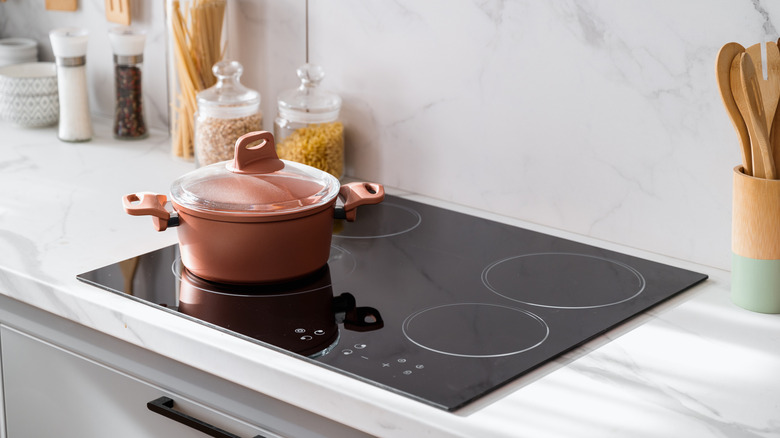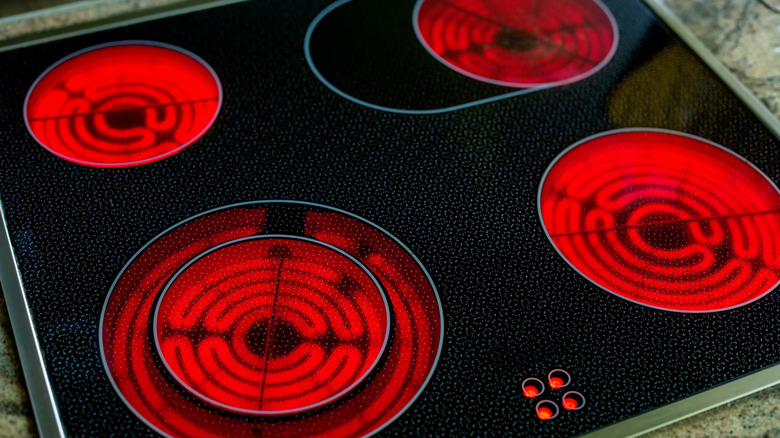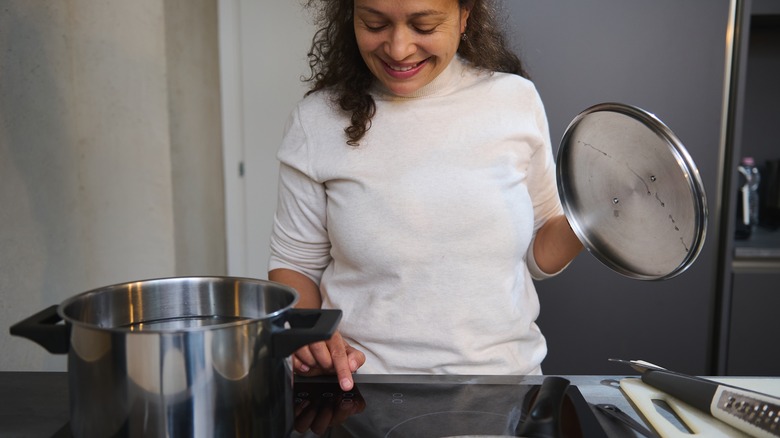The Difference Between Electric And Induction Stove Tops
While it's easy to see the distinction between a gas and induction stovetop thanks to the exposed coils, the differences between an electric and induction stovetop are a bit harder to identify. Both of these gadgets are made up of sleek glass surfaces, and many come with the same modern digital controls in lieu of buttons or knobs. Still, while these two stovetops may appear similar, there's a lot that sets them apart.
For starters, electric stovetops produce heat using metal coils kept underneath the glass surface, which transmit electricity. (Hence the name.) Alternatively, induction stovetops heat food using specifically copper coils, which produce energy from underneath the glass surface — and with induction stovetops, the energy is made up of electromagnetic pulses instead of heat. While these differences might seem minimal, they make for big changes in how each of these stovetops cook. Because while electric stovetops actually heat up the stove's surface, induction stovetops can only heat up the actual cookware that sits on top of it.
The big distinctions between the stovetops
While induction stoves might be the hot new thing, there are pros and cons to each of these options, so making a choice really just comes down to your personal preferences and needs. For example, some people might not love that you can only use certain pots and pans on induction stoves: Ones that respond to electromagnetic energy. The cookware has to be magnetic so the energy of the stovetop can transfer from the coils to the pot. Luckily, most common cookware, such as cast-iron and stainless steel, can interact with induction stoves, so it's not too big of a barrier. (Still, if you're a fan of glass or copper pots, you're out of luck.) Since an induction stovetop won't get hot unless a compatible pot is on top of it, it makes for a safer kitchen space. But if you don't use compatible cookware, the stovetop will not get hot.
Now, an electric stovetop can get hot no matter what type of cookware you use, so it's a very accessible option. Still, this means that if you accidentally leave something on the burner, there's nothing stopping the heat from spreading, so there's no failsafe mechanism here. Plus, since they take longer to heat up and cool down, electric stovetops are also more prone to energy-wasting mistakes.
How to decide which stovetop is best for you
Because of an induction stove's unique heating technique, it can generally cook meals much faster than electric stovetops thanks to that direct transfer of energy. So, from basic stovetop steamed rice to complex proteins, you can cook it all in almost half the time. Additionally, it's easier to control the temperature levels on induction stovetops, as the precise sizes of the burners make for direct heating. It's also a safer option than electric, and more energy efficient, too. Plus, because the surface of an induction stovetop is flat with no exposed coils, it's also super easy to clean.
Still, induction stovetops are more expensive than electric, so there's a higher barrier with the initial purchase here. Also, for visual chefs, an electric stovetop might be the better choice, as you can actually see the stove heating up — unlike with an induction, where there's no indication that the heat is on. For those that like to employ a wide variety of cookware, electric might also be the better choice for you.
At the end of the day, it all comes down to personal preference. While some say induction cooking is superior, others prefer electric, so weigh the pros and cons to decide which option is best for you.


